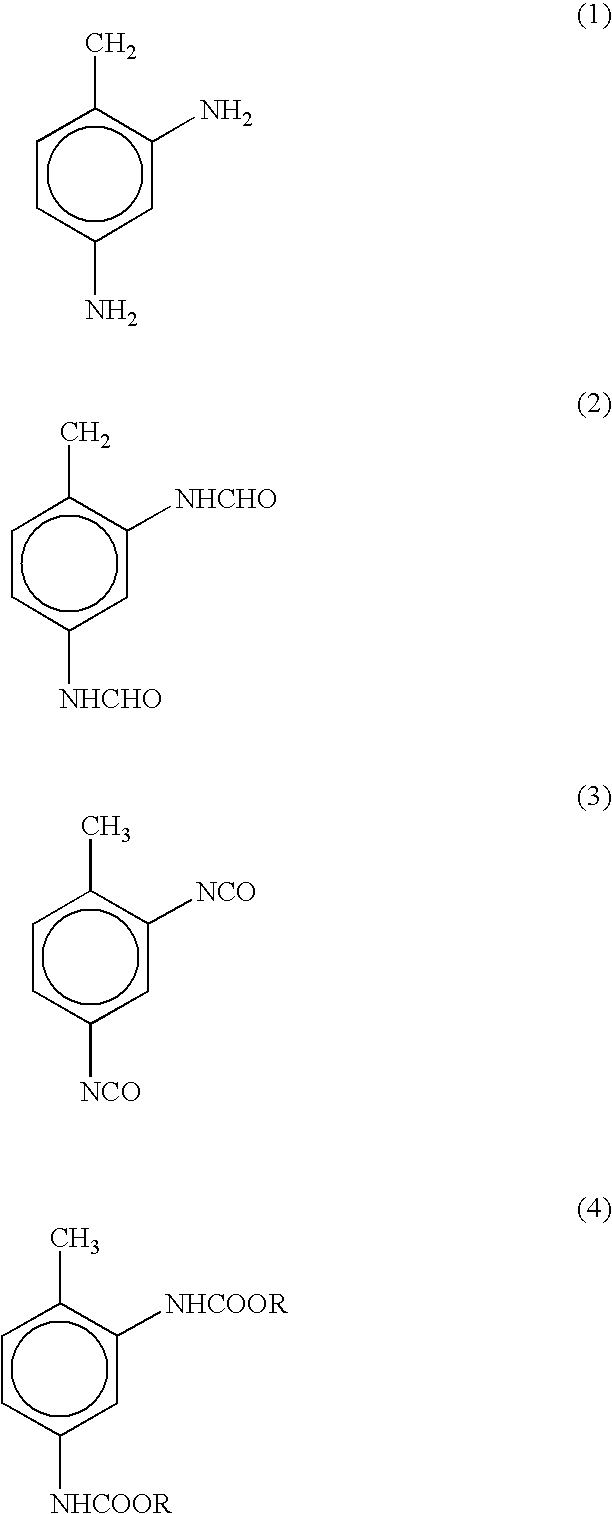Non-phosgene route to the manufacture of organic isocyanates
a technology of isocyanate and phosgene, which is applied in the preparation of isocyanic acid derivatives, organic chemistry, carbamic acid derivatives, etc., can solve the problems of preventing their commercial use, high cost of phosgene used in isocyanate production, and limited commercial value of byproducts such as hydrochloric acid, so as to achieve the effect of generating little waste and efficient overall process
- Summary
- Abstract
- Description
- Claims
- Application Information
AI Technical Summary
Benefits of technology
Problems solved by technology
Method used
Image
Examples
example 2
The di-formamide of 2,4-toluene diamine is prepared by either reaction of the diamine with formic acid, with azeotropic removal of water with refluxing toluene, or by reaction of the diamine with phenyl formate in phenol. As in Example 1 above, the di-formamide (5.46 grams, 0.0307 mole) in phenol (17.50 grams, 0.186 mole) is added dropwise to diphenyl carbonate (26.40 grams, 0.123 mole) and heated to 232.degree. C. at 110 mmHg. IS / GC analysis of the overhead (30.55 grams) and pot material (17.42 grams) shows the recovery of 4.004 grams of free 2,4-TDI and 0.277 grams of 2,4-TDI as phenol carbamate (0.0246 moles total TDI, 79.9% yield, based on di-formamide fed).
example 3
A mixture of 15.69 grams, 0.0881 mole of 2,4-toluene-diformamide, containing an additional 0.04 grams of phenol, and 143.16 grams, 0.6684 mole of diphenyl carbonate is heated, with magnetic stirring, to reflux at 160 mmHg. Distillation commenced at 212.degree. C. pot, 143.degree. C. distillate temperature and is terminated 35 minutes later at 237.degree. C. pot and 196.degree. C. distillate temperature. The 40.55 grams of distillate contains 4.072 grams of TDI, while 10.506 grams of 2,4-TDI remains in the 117.62 grams of pot material, a total recovery of 14.578 grams of 2,4-TDI, 0.838 mole, for a diformamide to diisocyanate yield of 95.1%.
example 4
To a 5 ml vial is added (2.00 grams), 2,4-toluene-diformamide (0.458 grams, 2.57 mmole) and methylphenylcarbonate (1.56 grams, 10.26 mmole). The solution is heated to 199.degree. C. with stirring. Complete conversion of the diformamide to 2,4-toluene diisocyanate-bis(methanolcarbamate) occurs within 45 minutes. Anisole was formed as a byproduct.
PUM
| Property | Measurement | Unit |
|---|---|---|
| Angle | aaaaa | aaaaa |
| Angle | aaaaa | aaaaa |
| Substance count | aaaaa | aaaaa |
Abstract
Description
Claims
Application Information
 Login to View More
Login to View More - R&D
- Intellectual Property
- Life Sciences
- Materials
- Tech Scout
- Unparalleled Data Quality
- Higher Quality Content
- 60% Fewer Hallucinations
Browse by: Latest US Patents, China's latest patents, Technical Efficacy Thesaurus, Application Domain, Technology Topic, Popular Technical Reports.
© 2025 PatSnap. All rights reserved.Legal|Privacy policy|Modern Slavery Act Transparency Statement|Sitemap|About US| Contact US: help@patsnap.com



